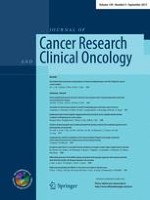Published in:

01-09-2013 | Original Paper
The identification of a small but significant subset of patients still targetable with anti-HER2 inhibitors when affected by triple negative breast carcinoma
Authors:
Eleonora Brunello, Giuseppe Bogina, Emilio Bria, Marco Vergine, Giuseppe Zamboni, Serena Pedron, Isabella Daniele, Jenny Furlanetto, Luisa Carbognin, Marcella Marconi, Erminia Manfrin, Merdol Ibrahim, Keith Miller, Giampaolo Tortora, Annamaria Molino, Bharat Jasani, Serena Beccari, Franco Bonetti, Marco Chilosi, Guido Martignoni, Matteo Brunelli
Published in:
Journal of Cancer Research and Clinical Oncology
|
Issue 9/2013
Login to get access
Abstract
Purpose
Triple (ER-, PR-, HER2-) negative breast carcinoma lack targeted therapies, making this group of tumors difficult to treat. By definition, the lack of HER2 expression means a case scoring 0 or 1+ after immunophenotypical analysis and makes the patients avoiding therapeutical chances with anti-HER2 inhibitors. We sought to recruit from a group of triple negative breast carcinoma, patients eligible for effective personalized targeted therapy with anti-HER therapies on the basis of their HER2 gene status.
Methods
135 patients diagnosed with IHC triple negative breast carcinoma were studied. Whole tissue sections were used for in situ hybridization analysis.
Results
8/100 (8 %) of ductal-type triple negative breast carcinoma presented Her-2/neu gene amplification versus 2/35 (5.7 %) non-ductal triple negative breast carcinoma. Three cases showed a ratio 2.5. One case showed Her-2/neu heterogeneous gene amplification, ratio 2.3. The other six showed from 7 to 8 absolute Her-2/neu gene copy number. Two cases staged pT1c, and eight cases staged pT2. Eight cases graded G3 and two cases G2.
Conclusion
(1) Eight percentage of ductal and 5.7 % non-ductal-type triple negative breast carcinoma present Her-2/neu gene amplification, (2) the standard diagnostic flowchart “do not FISH in 0–1+ (HER2-) breast carcinoma” should be replaced by “do FISH in triple (ER-, PR-, HER2-) negative breast carcinoma,” to avoid loss of therapeutical chances in a cohort of such a patients, (3) we demonstrated the identification of a small but significant subset of patients targetable with anti-HER2 inhibitors, giving patients affected by (ex)triple negative breast carcinoma new personalized therapeutical chances.





